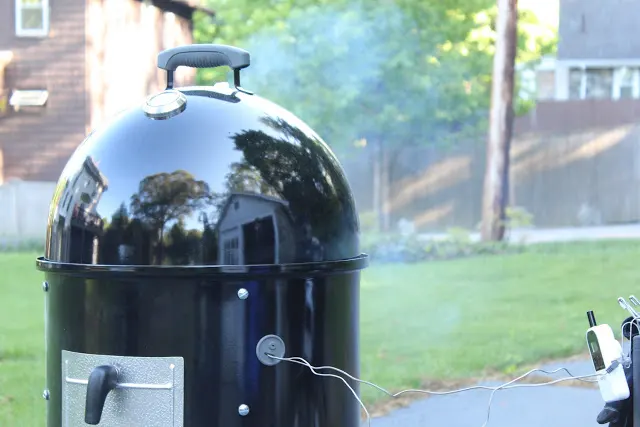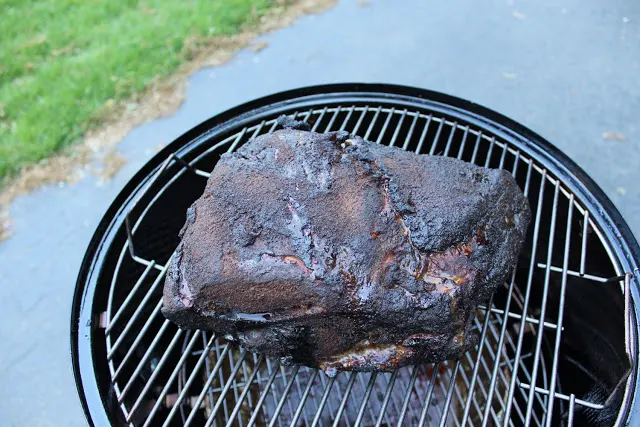Guest Post from Ryan: Pulled Pork Recipe

About ten or so years ago I first experienced the pride of cooking a well-enjoyed meal. On vacation in rural Western Massachusetts, I cooked Hannah and some of our friends burgers. I wasn’t expecting anything beyond adequacy. There was no lightning on the porch with the grill, so it was lit by the headlights of my Altima. I was very pleasantly surprised to have so many complements. Since then, burgers have always been the one thing I can cook well.
It was time to take grilling a bit further out of my comfort zone and try something more elaborate, something less mundane: smoked meats.
I started with pull pork. Boston butt, to be more exact.
This recipe is for about 10 pounds of pulled pork. How much you make is up to you and your butcher. Given the time involved, it’s advisable to make several pounds at a time so that you can have leftovers in the freezer. They can be quickly reheated and (optionally) tossed in a burger bun for a quick meal.
Ingredients
Meat:
- A Boston butt, roughly 10 pounds. I usually buy these from BJ’s. I have not been able to find them at supermarkets.
The rub:
- 3 tbsp granulated sugar
- 3 tbsp smoked paprika
- 2 tbsp salt
- 2 tbsp dark brown sugar
- 1 tbsp cumin
- 2 tbsp black pepper
- 1 tbsp onion powder
- 1 tbsp garlic powder
Tools:
- A meat smoker. These instructions are written for a Weber Smokey Mountain.
- A dual-probe remote thermometer
- My spreadsheet for tracking temperature and vent positions.
- A chimney charcoal starter and second grill to start them on. Do not start charcoals on your driveway!
Fuel:
- Several pounds of charcoal. I prefer Kingsford Original (blue bag).
- Chunks of applewood and hickory. Weber sells small packages of wood that can be found at Home Depot or Lowe’s.
Meat Preparation
The night before the smoke.
Trim the fat off the meat using a sharp knife. If you trim around the perimeter you should be able to peel it away. The goal is to ensure the outer surface is meat that will be rubbed your seasoning. This will eventually become bark, the crunchy seasoned part. Any fat will melt away as will its seasoning.
Mix the ingredients of the rub. Make adjustments along the way to suit your tastes. Don’t worry about measuring and getting it exact. Measuring is for Germans.
Once the meat is trimmed and your rub is mixed, you’re ready to apply the rub. I find it easiest to use a large casserole pan. Place the meat in it and rub the seasoning into the butt. Flip it over and get the underside.
It’s very important that you are patient and make sure your butt is completely rubbed. (That’s what she said.)
Cover the pan with plastic wrap, using toothpicks to keep the wrap from clinging. Refrigerate overnight.
Smoker Preparation
I like to get ready the night before so that I am ready to fire up the smoker first thing in the morning. It takes at least 8 hours to smoke 10 pounds, without cheating in the oven. I like to make sure that I can finish as early in the day as possible and account for any problems that could cause a delay.
Clean the smoker and wrap your water pan in tin foil.
Load your smoker with fuel. I use the Minion Method, with 40 briquettes placed around the outer perimeter of the base.
Add four pieces of applewood and one piece of hickory, placing it on top of the charcoal on the outer edge. The wood will be ignited a bit further into the smoke, when these briquettes are loaded.
Fill a chimney with briquettes. These will be lit in the morning and will ignite the rest of your fuel.
Place one of your two thermometer probes on a grate in your smoker. In my Weber Smokey Mountain, I mount it in the middle of the bottom grate.
Smoke Day
Set your alarms early. It’s the big day. Wake up at least 14 hours before you want to have your meat finished and on the table.
Actually, you should set your alarm the night before.
First, light the briquettes in the chimney. As those are getting up to temperature, fill your water pan with about a gallon and a quarter of water. This helps evenly distribute heat.
Since the briquettes are going to take a while to get up to temperature, I’d use this time to turn on and synchronize your wireless thermometer. When the coals are ready; that is they’re either all glowing or covered in ash, dump them in the center of your fuel.
You can begin to put the smoker back together and place your meat on the center of the top grate. Leave all vents open halfway.
Now that your fuel is lit, it’s important that you keep the smoker sealed and open it only when necessary. In other words, treat it like you would any door when your mother is around. You don’t want her to ask if you live in a fucking barn.
Take note of your temperature and vent positions periodically. You’ll want to keep the smoker around 240 - 260 degrees. Open the vents to allow more air, which will result in more combustion to increase the temperature. Conversely, close the vents to suffocate the fuel and reduce temperature.
Now it’s just maintenance. Keep an eye on the temperature of the smoker and meat. You’ll need to add briquettes and wood occasionally when fuel runs low.
Pork is safe to eat at 160 degrees, but it’s tough. You’ll want to get the temperature up to 203 degrees. Be patient.
When you encounter a stall (typically around 150 degrees), you’ll want to try the Texas crutch. Wrap the butt in foil. This will prevent any escaping moisture from evaporating and cooling your pork butt. Cue sweaty butt jokes.
When the meat gets up to temperature, take it off the smoker and pull it apart with two forks.
Serve on white burger buns. I like the cheap store brand ones best. Any fancy bread distracts from the flavor of the meat and ruins it.
Ingredients
Instructions
